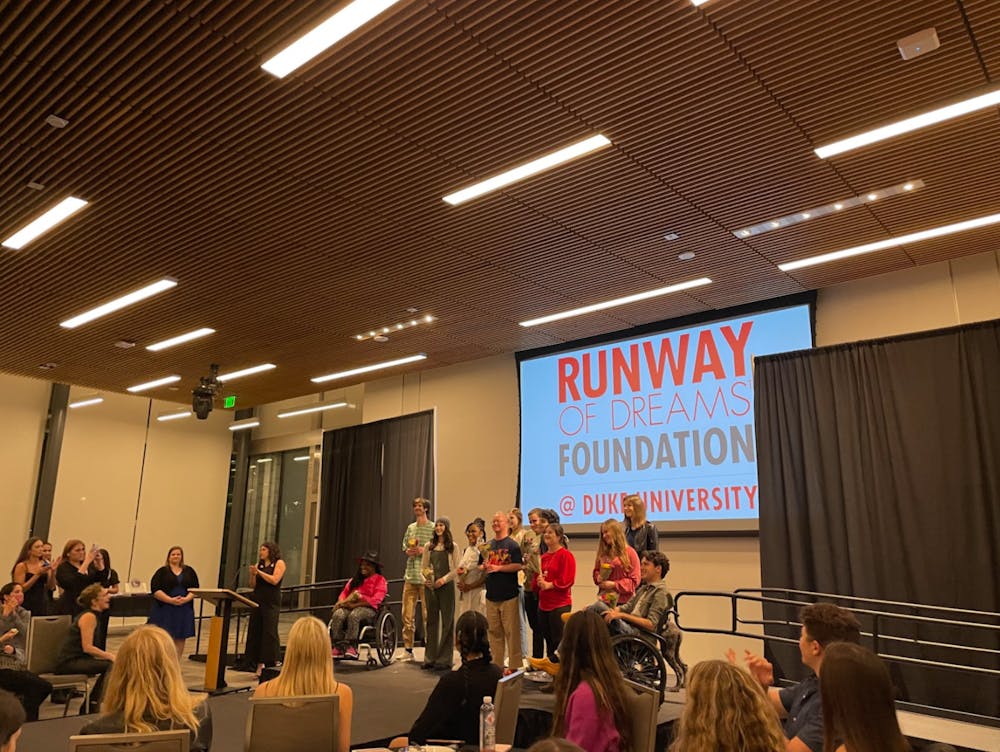The annual adaptive fashion show, brought by Runway of Dreams at Duke, brought some bright colors to the gloomy spring weather on campus last Thursday. This was the club’s second annual show and their first to be held in person.
Runway of Dreams was founded in 2014 by Mindy Scheier. As a woman with a background in fashion design and as a mother raising a son with muscular dystrophy, Scheier was inspired to create such a platform.
“When [my son] was in first grade he came home from school and said that he wanted to wear jeans to school like all of his friends,” Scheier said in an interview with AXSChat.“I decided that I needed to take my background and figure out ways that mainstream clothing could be worn by people with disabilities.”
According to the national mission statement, Runway of Dreams is an organization that “empowers people with disabilities with confidence and self-expression through fashion and beauty inclusion.” The organization holds annual adaptive fashion shows that celebrate the fashion industry’s latest advances in inclusion and empowerment for individuals with disabilities.
Students from many colleges across the country have joined in this “Campaign for Inclusion” by establishing Runway of Dreams clubs on campus. Duke’s Runway of Dreams chapter (ROD Duke) was brought to campus by senior Emma Steadman and sophomore Abigail Ullendorff in fall 2019. Now, the executive board has 10 members.
“As a mechanical engineering student and the kind of girl who loved playing dress up as a little kid, I became consumed with the idea of creating innovations that would give people with disabilities autonomy while dressing themselves and the ability to feel confident in what they’re wearing,” Steadman said in a 2021 article before the club’s first show.
ROD Duke’s second annual adaptive fashion show “Spring Into the Future of Fashion” featured 14 models with disabilities from the local area. At least five of the models at the show are NC State students, and one is a doctoral candidate at Duke. The models’ apparel was designed by Zappos Adaptive, Minor Details, è Ispirante and most notably, ROD Duke’s very own design team that consisted of eight students.
“We are a team of about 10 people ranging from freshmen to juniors with a wide range of majors, interests and passions,” said junior Grace Cassels, the leader of the design team. “We all share one passion, which is our passion for adaptive design. And that's what we come together to do every Monday night. Our team includes disability studies students, engineering majors, people who are interested in going into the fashion industry, people who have been sewing since they were little [and] people who have never used a sewing machine at all — myself included.”
Working with a model for the show, Rose, who had cochlear implants due to loss of hearing, Cassels and her team designed an adaptive beanie.
“It’s very difficult for people like Rose who have these implants to wear hats since the fabric of the hat can muffle or interfere with the transmission of sound and it can just be uncomfortable,” Cassels said. “So the design team worked with Rose to create a few different designs and prototypes of hats and beanies that would work to solve these issues. And we did so by eliminating the fabric surrounding the cochlear implant where the hat would sit on top of it, which basically means just cutting a hole in the hat. But we tried to make it adjustable so that people who have different types of cochlear implants or have it in a different location on their skull have the ability to adjust it to whatever their needs are.”
What sets Runway of Dreams show apart from other fashion shows is its emphasis on models’ unique stories. For instance, in its March 15 adaptive show held in Los Angeles, Scheier highlighted the story of model Oskana who escaped from Ukraine to attend this show that had been planned for four years
“She risked her life to escape Ukraine, get to Poland, come from Poland to Los Angeles, and she is on this runway tonight,” Scheier said.
Similar to the national show, ROD Duke’s show started off with a video where some models introduced themselves. From the video, audiences got a chance to get to know the models on a more personal level, learning about their occupations, hobbies, personalities and aspirations.
“This is my first [adaptive clothing] show, which I’m super excited about because putting on clothes for me is like getting into a fight,” one model noted in the video, “but hopefully I'll win this battle with this adaptive clothing.”
The actual runway portion of the show was brief, lasting approximately 10 minutes. To some extent, the length shows how much visibility, awareness, support and resources are still needed for people with disabilities. With continual efforts from dedicated individuals such as the members of Runway of Dreams, there is hope that we can close this inclusion gap in the foreseeable future.
Get The Chronicle straight to your inbox
Signup for our weekly newsletter. Cancel at any time.
Katherine Zhong is a Trinity junior and local arts editor of The Chronicle's 119th volume.

